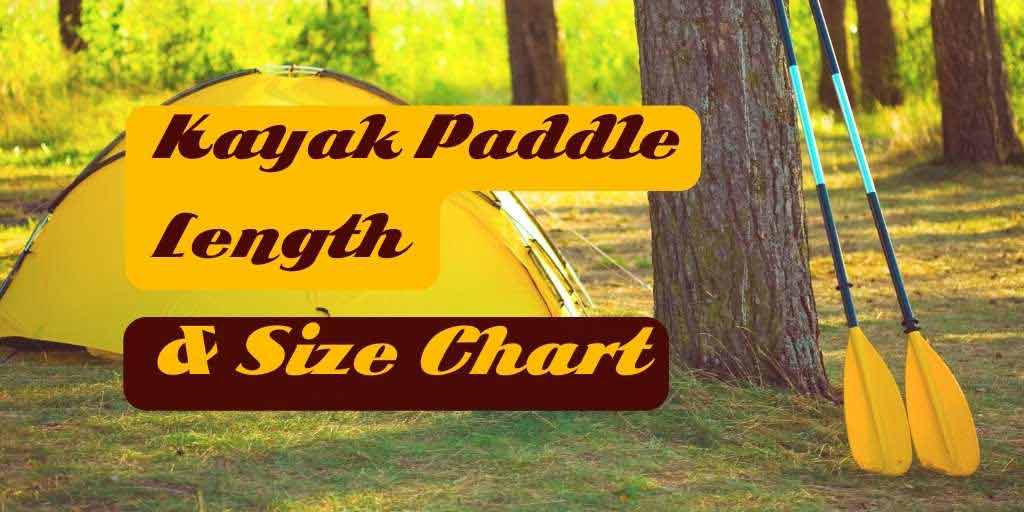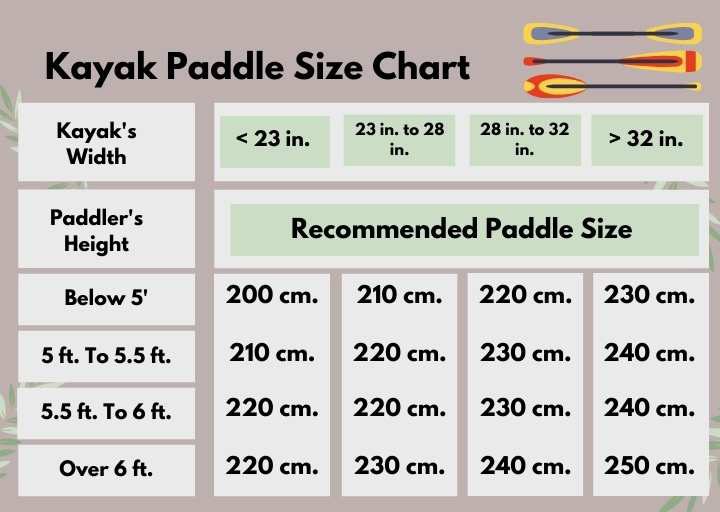The feeling of paddling through the water, the wind in your hair, and the sun on your face is unbeatable! But one thing that can ruin your kayaking experience is the wrong paddle size. Moreover, choosing the right paddle size for your kayak can be a challenging decision.
There are a bunch of different factors to consider, such as paddle length, blade size, and materials. But with all the different sizes and styles out there, how do you know which one is right for you?
Of course, these are basic general guidelines! The best way to know for sure what size paddle you need is to try out a few different ones and see what feels comfortable for you.
But the following guidelines will help you narrow down your choices and get you to find the perfect kayak paddle size for you.

Jump To A Section
What Size Kayak Paddle Do You Need?
Choosing the right paddle size for your kayak or canoe can be confusing. You want a paddle that’s comfortable to use, but you also want one that provides the most power and efficiency. The key is to find a balance between the two.
Here’s how you find the right size kayak paddle for you;
Your height
The length of your paddle should be proportional to your height. If you’re tall, you’ll need a longer paddle. If you’re shorter, you’ll need a shorter paddle.
The conditions you’ll be paddling in
The conditions you’ll be paddling in will also dictate the shape of the paddle you need. If you’re paddling in calm waters, you can get away with a thinner blade.
But if you’re paddling in choppy waters, you’ll need a paddle with a thicker blade.
material
The material of your paddle should be durable and able to withstand the elements. Kayak paddles are typically made of wood, fiberglass, or carbon fiber.
width
The width of your paddle should be proportional to the width of your kayak.
If you have a wide kayak, you’ll need a wider paddle. If you have a narrow kayak, you’ll need a narrower paddle.
weight
The weight of your paddle should be proportional to the weight of your kayak.
If you have a heavy kayak, you’ll need a heavier paddle. If you have a light kayak, you’ll need a lighter paddle.
shape
The shape of your paddle should be comfortable for you to grip and should allow you to paddle efficiently. Kayak paddles typically have a teardrop shape or a blade shape.
Keep these things in mind when you’re shopping for a kayak paddle, and you’ll be sure to find the perfect paddle for you and your kayak.
Learn to Calculate Kayak Paddle Length
When it comes to kayaks, one size definitely does not fit all.
In fact, there are a few things you need to take into account when choosing a kayak paddle, one of the most important being paddle length. Just as the length of a kayak needs to be appropriate for your height, the length of your paddle should also be relative to your height and the width of the kayak.
Here’s a quick guide to help you calculate the right kayak paddle length for you.
To start, sit in your kayak in the paddling position. Place the paddle in front of you and hold it perpendicular to the ground. Next, measure the distance from the ground to the top of your head. This is your height.
Now, take your measuring tape and hold it against the side of the kayak at the widest point. This is the width of your kayak.
To calculate the ideal paddle length for your height and kayak width, simply divide your kayak’s width by 2.5. For example, if your kayak is 24 inches wide, your ideal paddle size would be approximately 9.6 feet (24 inches divided by 2.5).
Keep in mind that this is just a general guide. If you’re going to be doing a lot of paddling in open water, you may want to go with a slightly longer paddle. Conversely, if you’ll mostly be paddling in tight spaces, you may want to go with a slightly shorter paddle.
And that’s all there is to it! With a little bit of simple math, you can easily calculate the ideal kayak paddle length for you.
How to Calculate Kayak Paddle Size according to your height?
How do you know what length paddle you need for your height? If you are taller, you will need a longer paddle. If you are shorter, you will need a shorter paddle.
However, the general rule of thumb is that you should add 10 inches to your height to get the correct paddle length. So, if you are 6 feet tall, you would need a paddle that is at least 70 inches long.

Longer paddles vs shorter paddles for kayaking
The debate about longer kayak paddles vs shorter kayak paddles has been around almost as long as the sport of kayaking itself. It’s a topic that stirs up a lot of passion in the kayaking community, with people strongly advocating for one side or the other.
So, what are the advantages and disadvantages of using a longer or shorter paddle when kayaking? Let’s take a look.
Longer Paddles For Kayaks
Longer paddles provide more power and are better for straight-line paddling. They’re also more stable in windy conditions. On the downside, longer paddles can be more difficult to maneuver and can be heavier and more difficult to transport.
Advantages of longer paddles
More power and speed
With a longer paddle, you can generate more power and speed, making it easier to cover distance quickly or fight against strong currents.
Greater reach
A longer paddle gives you greater reach, which can be helpful when paddling around obstacles or tight turns.
More leverage
Longer paddles also provide more leverage, making it easier to control your kayak and keep it on course.
Disadvantages of longer paddles
They can be cumbersome
Longer paddles can be cumbersome to transport and store and can be difficult to maneuver in tight spaces.
They can be difficult to control
Longer paddles can also be difficult to control, making it easy to lose your balance or tip your kayak over.
They can be tiring to use
Finally, longer paddles can be tiring to use, especially if you’re not used to them. If you’re planning on paddling for long periods of time, you might want to stick with a shorter paddle.
Shorter Paddles For Kayaks
In general, shorter paddles are best suited for beginners or for people who are just getting started with kayaking. Many people believe that a shorter paddle is better for kayaking, but there are some disadvantages to shorter paddles that you should be aware of.
Advantages of shorter paddles
They’re easier to transport and store
Shorter paddles are much easier to transport and store and are less likely to get in the way when you’re maneuvering your kayak.
They’re easier to control
Shorter paddles are also easier to control, making it less likely that you’ll lose your balance or tip your kayak over.
They’re less tiring to use
Finally, shorter paddles are less tiring to use, making them a good choice if you’re planning for overnight kayak camping, and long touring.
Disadvantages of shorter paddles
1.
If you’re not used to paddling with a shorter paddle, you may find it difficult to keep your kayak in a straight line. This can be frustrating, especially if you’re trying to paddle in a straight line!
2.
Shorter paddles can also be less stable. If you’re paddling in choppy waters, a shorter paddle can make it more difficult to keep your kayak stable.
This can be dangerous, so it’s important to be aware of the conditions before you paddle with a shorter paddle.
So, which is better – a longer or shorter paddle? It completely depends on your individual needs and preferences.
If you’re looking for more power and speed, a longer paddle might be the way to go. If you’re worried about control and maneuverability, a shorter paddle might be a better choice.
And if you’re planning for an extended kayaking trip, a shorter paddle might be more comfortable to use. Ultimately, the best paddle for you is the one that feels comfortable and works well for your particular kayaking style. But make sure you know how far can you kayak in a day.
As a general rule, shorter paddles are better for maneuverability, while longer paddles provide more power and stability. If you’re just starting out, it’s probably a good idea to go with a shorter paddle. This will help you get a feel for the sport and learn how to control your kayak.
As you become more experienced, you may find that you prefer a longer paddle. This is especially true if you’re planning on doing any long-distance kayaking. Longer paddles give you more power and stability, which can be helpful when you’re covering a lot of ground.
Ultimately, the best paddle size for kayaking is the one that feels comfortable for you. Experiment with different lengths and see what works best for your paddling style.
Choosing between a short wide blade and a shorter narrow blade
Choosing the right kayak blade is a critical decision that will have a big impact on your paddling experience. There are two main types of kayak blades – short wide blades and shorter narrow blades. Each has its own advantages and disadvantages, so it’s important to choose the one that’s right for you.
Short wide blades are great for beginners because they’re easy to control and provide good stability. They’re also good for paddling in flat waters. However, they can be difficult to maneuver in tight spaces and are not ideal for paddling in rough waters.
Shorter narrow blades are more suitable for experienced kayakers who are looking for a more challenging paddling experience. They’re more maneuverable than short wide blades and can be used in both calm and rough water. However, they can be difficult to control in windy conditions and are not as stable as short wide blades.
So, if you’re just starting out, a short wide blade may be a good choice. But if you’re looking for a more challenging paddling experience, a shorter narrow blade may be a better option.
What To Consider When Choosing Paddle Size For Kayak
When it comes to choosing a kayak paddle, size matters. But how do you know what size kayak paddle to get?
There are a few things to consider when choosing a kayak paddle, including the width of your kayak and your own height and weight.
The width of your kayak will determine the minimum paddle length you need. For example, a kayak with a 24-inch beam would need a paddle that’s at least 84 inches long.
Your height and weight also play a role in choosing a kayak paddle. A paddler who is taller and heavier will need a longer and heavier paddle, while a paddler who is shorter and lighter can get away with a shorter and lighter paddle.
So how do you find the right size kayak paddle for you? Here are a few things to keep in mind:
Measure your torso
Well, the length of your kayak paddle is dependent on your torso, so you need to measure your torso in order to know what size you need.
The size of your arms and legs is also a factor to consider when measuring your torso. If you have long arms or legs, you will need a longer paddle. Conversely, if you have short arms or legs, you will need a shorter paddle.
Once you have your measurement, you can then choose a paddle that is the appropriate length. For a short torso, you’ll want a paddle that is around 210cm. For a medium torso, a paddle around 220cm is ideal. And for a large torso, you’ll want a paddle that is around 230cm.
Consider your stroke angle
One important to consider when defining the paddle size is the stroke angle. This is the angle at which you’ll be paddling the kayak or canoe. A higher stroke angle means that you’ll be using more of your upper body to power the paddle. A lower stroke angle means that you’ll be using more of your lower body.
If you have a higher stroke angle, you’ll want a shorter paddle. This will give you more control over the kayak or canoe. If you have a lower stroke angle, you’ll want a longer paddle. This will give you more power.
Once you’ve considered the stroke angle, it’s time to try out a few different paddle sizes. It’s best to try them out in the water so you can get a feel for how they handle. And, be sure to ask other kayakers or canoeists for their opinion. They may have some great insights that you didn’t consider.
Consider the blade size
When you’re planning to buy a kayak paddle, it’s important to consider the blade size. The blade size will affect the length of the paddle, and you want to make sure you get a paddle that’s the right size for your kayak.
Blade size is measured in inches, and the most common sizes are 7, 8, and 9 inches. If you have a small kayak, you’ll want a smaller blade size. If you have a large kayak, you’ll want a larger blade size.
Lastly, the best way to figure out the ideal kayak paddle length starts by measuring your body size, strength, and trip plan. Once you’ve found the perfect paddle size for your kayaking needs, you can start planning your next kayaking adventure!


